Red Peony Gambler, Red Peony Gambler 2: Gambler’s Obligation (1968, 1969)
Directed by: Kôsaku Yamashita, Norifumi Suzuki, Tai Kat?
Written by: Motohiro Torii, Norifumi Suzuki, Tatsuo Nogami
Starring: Kanjûrô Arashi, Ken Takakura, Kyôsuke Machida, Michitarô Mizushim, Sumiko Fuji, Tomisaburô Wakayama
RED PEONY GAMBLER 1 – 3
AVAILABLE ON BLU-RAY: NOW, from EUREKA ENTERTAINMENT
REVIEWED BY: Dr Lenera
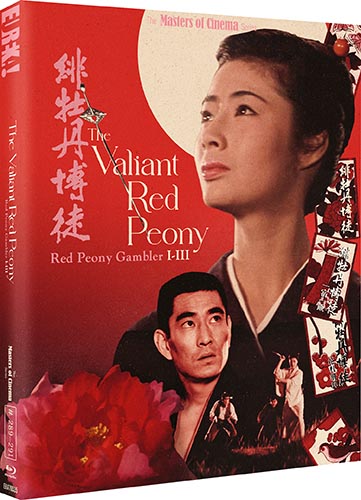
DISC ONE
RED PEONY GAMBLER [1968]
AKA HIBOTAN BAKUTO, LADY YAKUZA
RUNNING TIME: 98 mins
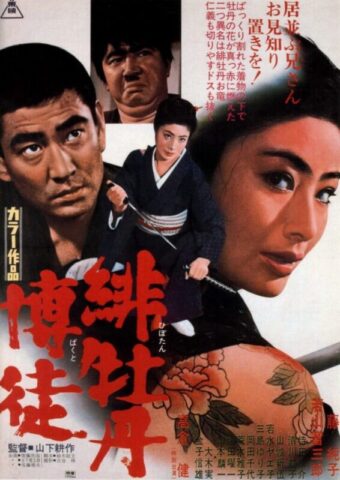
In a gambling hall, a Yakuza disgraces his clan when he accuses a stranger named Fujimatsu of cheating but is exposed by a lady for cheating himself. He’s ordered to cut his own finger off, while the lady leaves, clearly on some kind of mission. The cheater follows her with some others and they try to kill her, but along to her aid comes swordsman Kataguri. She tells him that was once Ryuku Yano, the daughter of a Yakuza boss, but is now called Oryu the Red Peony, and is out to avenge her father’s murder. Kataguri seems interested in a wallet she accidentally drops, and steals it while she’s asleep. She’s annoyed, but won’t be deterred from her mission, and gets involved in a feud between two local clans. It seems that the killer might be nearby….
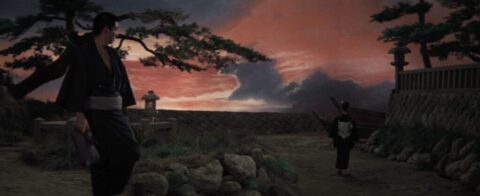
The first question you may ask about these films, of which there are eight – Eureka offer the first three – is why does this first episode contain the word “peony” in its title when, if you go by the IMDB [which admittedly you sometimes shouldn’t] that word is “pony”. Well that earlier translation was amusingly wrong, we’re talking flowers not horses – so this film certainly isn’t called The Valiant Red Pony, which sounds like it should be a cute kid’s movie. I’m going to be honest and admit that I hadn’t heard of these until a week or so ago when this release popped through my letterbox. My experience with Yakuza movies up to now has been the modern-set type, but of course many were set in the past too, seemingly a combination of the Yakuza and the Chambara film, which of course reminds us that the Yakuza were in many ways direct descendants of the Samurai. And a fair few also had female leads, seemingly before Hong Kong got into the act and way before their “femme fatale” phase. Hollywood’s claims of female-led action movies being a new and revolutionary thing seems ever more ignorant and arrogant. Though, judging by the first episode which I assume is relatively representative of the series, these aren’t really actioners. Red Peony Gambler has brief bursts of violence and a mayhem-filled final act, but is more concerned with drama as its potentially simple revenge tale develops into a group of related subplots which sometimes slow the pace down but remain usually interesting, while the two main plot strands develop into quite powerful stuff where the viewer is really caught up in the character relationships and their emotions. I found the film rewarding in a somewhat different way than expected, but still rewarding. And I remain in awe of how authentic a film like this seems – we really do feel like we’re in the period – despite obviously being shot entirely on sets.
By god does our heroine get a great introduction. She appears as a silhouette against a red background, kneeling down as she speaks. “Leader and sister of the clan, you do not know me, but I seek your support. This is the first time that I have been invited to be in your honourable presence. Allow me to introduce myself. I am from Higo, Kumamoto. I was born in Itsuki, Kimamoto. My name is Ryuku Yano. I go by the name Oryu the Red Peony”. We get a slow zoom into her as she continues. “As you can see, I’m nobody special. Kindly remember me from this point on, and grant me your support”. The title appears over three white flowers before we cut to s gambling board – I have no idea what the game is called – and Ryuku sitting at a table before the board with lots of people around said table as the words “The Takehana Clan In Iwakuni” come up, plus a song with certain lines like “even a tough woman is just a woman after all” which may irritate some modern viewers but which actually sets up the main theme of these films, or at least this one though I’m sure it will be continued – the position of a woman in a male-dominates environment. A stranger in town is accused of cheating, and is threatened, but he announces “I’m Fujimatsu the Immortal, I’ve faced death many times and survived, go ahead if you dare”. Knives are pulled out, but then Ryuku says “just a minute”, and throws a tiny sword at a card to reveal that actually it was one of the Takahana lot who’d been cheating. “Don’t underestimate me because I’m a woman”, she warns, and the boss orders his foolish underling to cut off one of his own fingers for embarrassing him. Fujimatsu runs after Ryuku to thank her and ask if she would spend some time with him, but she’s “a lone wonderer“, and wonders off into the distance. It’s all so cool despite no sword slashing, and then she encounters the other main male protagonist, Kataguri, praying at the grave off his mother, against a gorgeous theatrical backdrop of a sunset.
Some Takahana guys show up and Kataguri helps Ryuku out, then seems extremely interested in a wallet she drops. We now finally get an explanatory flashback which tells us the background of Kyuku. When she was young her mother died from the stress of being married to a Yakuza, and her father, who was head of the Yano clan, became determined to ensure that she didn’t go through the same thing. But one evening, after being mocked at dinner by some visitors, she found her Dad dead, murdered seemingly by a street mugger – though that seems too simple, doesn’t it? In any case, after a great many days mourning, she changed her name to “Oryu”, derived from the crimson flower which is amidst two white ones tattooed on her shoulder, and which is what I’ll call her from now on. After asking her chief retainer Fugashin to “leave, become an ordinary man” she set off to find her father’s killer. But now she wakes up to find that Kataguri has mot just gone off but stolen her wallet. Why? She wonders on to find herself embroiled in a conflict by two other Yakuza clans, a conflict actually inadvertently began by Fugashin, who most certainly did not follow his boss’s instructions. And not only that but goofy clan leader Kumatura falls in love with her, Kumatura’s sister’s son sleeps with the wife of another man, and not just Fujimatsu but Kataguri shows up, wanting to recommence an old relationship, though the lady in question is now engaged to someone else, as well as reconnecting with his brother who’s just come out of prison. Kataguri also soon faces a very difficult dilemma in a tale which is really as much about him as it is about Oryu. The balance between all of this stuff happening is fairly well achieved, though the pacing noticeably slows around the middle for a bit, even if one appreciates that the film wasn’t attempting to be a thrill ride. But we tuly feel the dilemmas of some characters towards the end.
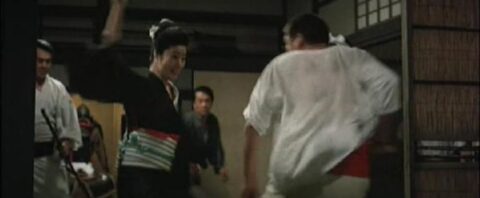
Combat is very convincing and, despite this only being 1968, already quite bloody with arm lopping, body slashing and gored faces. The early fight between Oryu and eight men, introduced superbly with a slow pan across all of the latter, which Kataguri soon joins, is mostly in slow motion, almost fetishising the act of combat. It’s brief, and contains a rather jarring change from daytime to nighttime in what is a generally very well made piece, but such scenes often were short in Japanese cinema, as opposed to its Hong Kong counterpart. We then have to wait until near the end for more proper fighting, but what we get, after a great killing scene shot through bars, is superbly choreographed, realistically rough and ready while still allowing us to appreciate and enjoy the staging. Sometimes mayhem takes place in two areas at the same time onscreen, while it’s refreshingly believable that our heroine prefers to use explosives and bullets until she runs out of both and has to pull out her dagger which she uses much like a sword. Unfortunately we don’t get a full-on showdown between heroine and villain, though then again the emphasis on drama, which allows for a few surprises, and which satisfies in a different way. And the very best scene might be when a major character is dying and asks Oryu to sing him a particular lullaby, which she does. This would be moving enough, but we also get a montage showing the connection between the two, which reveals that this person may have secretly been in love with Oryu. It’s not that often that films like this go for the emotion in such a full-on, in a way “western” fashion, but it works,. Then there’s the amusing sex scene, featuring minor characters, where we focus on feet [I bet you love this one Quentin] and socks.
There are lots of lines of the nature of “you fight men like it’s nothing, but you’re still a woman” and ‘you may make yourself out to be a man but you’re just a woman really”. It seems that, unlike in a lot in a lot of Hong Kong movies, we’re not intended to assume that Oryu has actually disguised herself as a man and that people are fooled by this even though the viewer most certainly isn’t and finds it hard to understand why characters are. Instead, it’s probably that she’s assumed the role of a man, which here means that some men talk to her as if she’s a man but realise all the time that she’s really a woman, and some just talk to her as if she’s a woman. Condescending comments from male characters towards her don’t seem to be backed up by the script, though what’s rather refreshing, in these days of flawless female heroines who can easily overcome any obstacle and are more capable than men at virtually everything, is that Oryu is definitely tough, skilled and clever but needs help from men at certain times. It will be interesting how this element develops – if it does at all – in the next two. This initial one is aesthetically rather pleasing, with one particular gloriously artificial set on the right hand side of the screen on one shot, plus a musical score by Takeo Watanabe that emphasises lyrical themes over the expected percussion and minimalism. Sumiko Fuji has a hypnotic quality as Oryu, and is great at playing the public holding back of strong emotion, though [with no disrespect to her], I was more interested in seeing the superb Ken Takakawa, an actor I first encountered and loved in The Yakuza from 1975, in an early role – though looking at his credits it wasn’t really an early role at all. Lone Wolf And Cub fans will recognise Tomiso Wakayama in a very hammy, goofy performance as gang boss Torakichi Kumasaka; he’s annoying here, yet his character would eventually get his own spin-off series, Silk Hat Boss. Red Peony Gambler generally sets a high standard. Will the first two sequels carry it on?
Rating: 









SPECIAL FEATURES
Audio Commentary by Chris Poggia
This track has its flaws but is still a worthwhile listen, and one probably needs to remember that there was probably hardly any information on the background and making of this movie, so he had to fill the track with something, and mentioning loads and loads of related films, and doing lots of biographies, was probably the easiest way to go. We do learn that there were strict orders that Oryu has to reveal her shoulder tattoos [which she actually does twice], while the historical placing of these films – which were extremely popular in Japan – is interesting for someone who’s not very knowledgeable about this genre. There’s also a lot of stuff about the American [us Brits hardly ever saw stuff like this in our cinemas] releases of this and similar films which I liked; Poggia first learnt about this one by reading a magazine from Marvel! Apparently they really got into the ’70s martial arts craze for a while, even though most of the films were hardly kiddie fare.
Original Theatrical Trailer
RED PEONY 2: GAMBLER’S OBLIGATION [1968]
AKA HIBOTAN BAKUTO: ISSHUKU IPPAN
RUNNING TIME: 95 mins
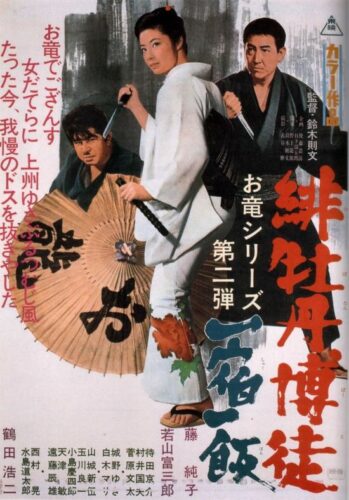
Oryu is now in another small town, known for its production of silk. However, a local loan shark named Gisuke Kuramochi has taken advantage of exceedingly bad harvests by the farmers there and is making it very difficult for them to repay their debt. He’s backed by a Yakuza boss who wants to take over the factory and indeed the town. Oryu is lodging with the town’s gang boss Eisuke Togasaki, who tries to reign in his son Yukichi. Yukichi wants to take action against Kuramochi and his men. but then Eisuke is betrayed by his assistant Yaichiro Kasamatsu and killed, allowing Kasamatsu to assume control of the place. Oryu decides to correct the situation, but also has to contend with another female gambler named Oren, along with some romance….
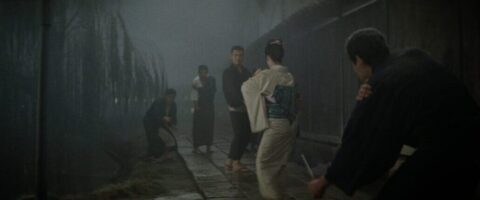
I have always admired the very long – though split up by some action beats – poker sequence in the 2005 Casino Royale. This is because it kept me interested and even in some suspense despite me not having any understanding of the game, which I feel is some feat – gambling scenes appear in many other Bond films but they’re short. Red Peony Gambler 2: Gambler’s Obligation has two games of “whatever people are playing”, the first one being quite long, the second being shorter but important because it decides the fate of some characters. However, my attention wavered during both because I didn’t have a clue what was going, even though it didn’t affect my interest during the 007 game. Oh well, I guess it’s not a big deal, especially seeing as this sequel is generally even better than its predecessor. Having a different director and cinematographer allows for a slightly different look and feel while not overdoing it so that it still works as a follow-up. The approach and structure are very similar though with a bit more fighting, a bit less sub-plotting, a bit more brutality, and a bit less of people being mouthpieces for the feminist theme even though that theme is still present and correct, all of which suited me fine and which to me also made for a better movie even though the first one already set a high standard and the formula hasn’t significantly changed. It’s also one of those rare sequels which follows directly on from the first film, yet which also most certainly doesn’t require the viewer to have watched film one to enjoy and understand film two – there are a few minor references from the latter to the former, perhaps most notably the return of one character, but they matter very little in the overall scheme. So is the perfect sequel? Well it must be up there, even it’s hard to tell how far up there without giving the subject a lot of thought.
We get a similar introduction of our heroine kneeling amidst lots of red, though her speech is shorter, finishing with “I’m still in great need of your help”. This time the titles take place over a night-time village dance where the credit for Fuji is accompanied by Oryu dancing in slow motion. A man with a gun looks like he’s going to shoot someone but he actually just fires his gun into the air to make everyone stop and pay attention. This is loan shark Kuramochi, just trying to intimidate, and after an altercation with another man is led away by police, then seemingly freed. Oryu, as we find out only later in a slightly curious bit of structuring, is staying with the local Yakuza clan for free but, as we learnt in the audio commentary for the first movie, she’s obliged to get involved and carry out Yakuza duties. She’s already made friends with Yukichi, the son of clan boss Eisuke Togasaki. There’s a meeting about this loan shark business which, perhaps unsurprisingly, involves another Yakuza clan which wants to tale over the factory because “times are changing, we must take advantage”. They aren’t human, they’re demons” cry the foremen about these bullies who’re demanding more and more payment from the silk factory workers. “Through three bad winters we’ve kept up with our payments, even if we’ve had to sell our daughters, but but this year, conditions are even more hopeless….they’re merciless, if we miss the due date by even one day….it’s mot unusual that the loan doubles in half a year.”. Yukichi wants to take action about this, but father insists on caution, on no breaking of the law. “As Yakuza, our job is to punish these crooks, I’ll do it if you won’t, I have twenty or thirty men who’ll follow me” is the response.
In contrast to the first instalment, the main scenario has been introduced immediately. It’s of course a very familiar one, but one which rarely fails to get viewer involvement. It’s only one that we get a proper re-intoduction to Oryu, in her seemingly favourite environment, being challenged by another female gambler named Oren, in one shot everyone else is moving but she’s still. Oryu wins, but she’s clearly made an enemy out of Oren, if not her under-the-thumb husband. Yukichi leads a gang to destroy a load of IOUs belonging to the loan sharks, though in a curious decision we don’t see this, even the fight which seems to ensure, though it’s mentioned as going on. This is disappointing, but an even more major event is handled in an effective way, as Oryu, and us, learns about the killing of Eisuke from reading the newspaper, whereupon we get a flashback where one group about to engage in a melee draws forth a load of swords – and are promptly, including Eisuke, gunned down by police which comprise the other group. Why? Then the por factoy workers get attacked and treacherous Oren is revealed to be part of a triangle, cheating on her impotent husband with him to get at Oryu, not to mention getting Yukichu wrongfully imprisoned, his wife Machi left at home with her very young nephew Taichi. We’re touched when she goes to see him in prison, their conversation separated by a barred window, not to mention Oryu herself forming a bond with a guy named Ryuku. The latter is very well handled; we feel the attraction but also the stoic reservations of the two people concerned who never really address it. With less minor stuff to clog things up, we’re totally invested in the main situation. We know much of what will transpire, but may not expect quite as much tragedy. Just as before, emotion becomes full blown, and the end scene of Oryu imagining she’s at the party we saw at the beginning, then banging the hell out of some drums, is genuinely moving.
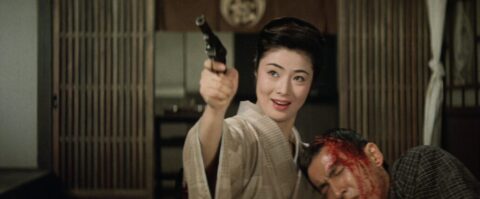
But what about the action. seeing as there’s more of it here, if still seeming to evolve naturally out of the plot? Oryu’s several encounters with groups which are menacing her are less polished than we saw before, and now employ some handheld camerawork, bit still just about convince, largely due to Fuji’s subtle projection of incredible power, and is even able to fight without weapons using Jujutsu, though the best part of all these bouts is the prelude to one, where Oryu uses an umbrella as a weapon in addition to her usual things, not the actual fight itself. We see her walking along down a street, the only colourful thing in a dark rain swept environment, then a group of thugs emerging out of the darkness to surround her. Director Norrifumi Suzuki and cinematographer Osamu Faruya use darkness more throughout, and of course I’m not just talking about the increased level of violence, where the fight scenes have relatively the same amount of bloodshed but there’s much more brutal stuff going on elsewhere. This includes several beatings of women, one who just simply lost at what she was told to do, something which is actually an important scene since it seems to deliberately contradict the suggestion elsewhere, even by our heroine in a stirring speech before loads of higher-ups, that the Yakuza are essentially noble even if they don’t always behave nobly. Another woman is raped, something very well evoked even though, unlike in a lot of later films, we don’t see the act, with the camera slowly panning up her body. An extremely gored stomach in the silk which is at the centre of this affair a very unsubtle but effective way of encapsulating it all.
Oryu clearly develops as a character, romantic feelings being the main thing but there are others. She seems to yearn for some peace, a quiet life. Eisuke says to her “establishing the Yano family is the most important thing to you, stop your traveling and training, leave the job of taking care of this district to me” – which continues the feminist theme but in a less forced way than before. We like Ryuku and when he says to her “I think a sowing needle will fit better than a knife” as a sort of proposal, we see it as sincere and not intending to be condescending the way it would seem to many if the film were made today. With the focus more on her rather than her and someone else almost equally, Fuji is given more opportunity to show her acting chops, perhaps most notably a scene with Machi when she talks of how she can’t have a relationship, even though Oryu is probably most defined when she marches into action accompanied by a song who’s words seem to fit her mind so much that it feels as if she’s actually doing the singing. Unfortunately we see the return of Tomiso Wakayama as Torakichi Kumasaka, now lusting after Oryu even more along with two other supposedly funny guys who also lust after Oryu. Their antics do lead to one amusing scene where he goes to peak at Oryu in the shower, finds the other two doing the same, knocks one of them into the door which knocks the door down too, which reveals the woman, who’d previously had her back to the voyeurs, to be another and far less attractive female character. Well, I laughed, though I didn’t laugh at anything else and found these bits to be more annoying padding than anything else. Nonetheless they’re the only iffy part of what’s an extremely satisfying piece.
Rating: 









SPECIAL FEATURES
Audio Commentary by Mike Leeder and Arne Venema
My favourite commentary pairing again show that it’s not just Hong Kong movies that they adore. We begin with learning from Venema that the setting is Kyushu, something that we couldn’t have learnt from watching the film alone, and that the festtival depicted is a New Year one. Indeed Venema almost seems to lead this one, certainly having more to say than usual, such as about how the Yakuza have changed in recent years, they now being more about money and less about honour and traditional things. Leeder focuses more on general appreciation of what we’re watching, and he clearly loves it, admiring especially how the romantic element is handled. While there’s a bit less jokiness than usual, we still get a few light-hearted digressions into subjects such as tattoos; Leeder obviously has some and asks Venema when he’s getting his first one. Not one of their outstanding tracks, but well balanced and you’re come away appreciating the film even more.
Original Theatrical Trailer
DISC TWO
RED PEONY GAMBLER 3: THE FLOWER CARDS GAME [1969]
AKA HIBOTAN BAKUTO: HANAFUDA SHOBU
RUNNING TIME: 96 mins

As she approaches another town, Oryu rescues a small child from being ran over by a train and hands her off to her mother who’s very grateful. She goes on to present herself to local Yakuza boss Teijiro Sugiyama, but is called a cheat by some. It seems that somebody is going around gambling house pretending to be her. Oryu sets out to find and confront this person, but a confrontation by Sugiyama’s gang and another is brewing because a lady named Keiko, who’s in love with someone else, is being forced into an arranged marriage with another clan leader,
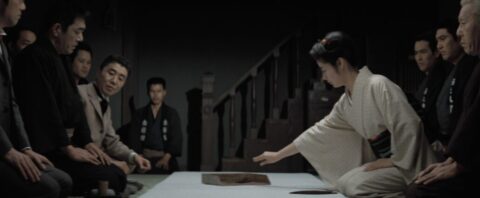
The formula for this series, unless the next few changed direction significantly, becomes quite obvious with this third episode where screenwriters Norifumi Suzuki .and Motohiro, even if supposedly basing their work on a novel by Hisakichi Ishimoto, give us a lot of variations on situations and ideas we’ve seen before, sometimes even in both preceding films as opposed to just one of them, though some of which are probably genre conventions. Our heroine involved with a feud between two clans. a rival female gambler, the gray area where Yakuza must operate as honorable and loyal even in the face of those who corrupt the institution, the increasing gulf between clan leaders and their sons or inferiors in a time of great change, a male wanderer who has some kind of agenda and becomes a love interest, and even another glorified cameo by Tomisaburo Wakayama who pops up again for a couple of scenes as Kumasaka for a few laughs – or should I say intended laughs. Was he in the next few episodes too? Perhaps the oddest thing is that Ken Takakura plays an extremely similar character, who functions in an extremely similar role, to his one in the first movie, but is obviously somebody else. But then again Takakura often played extremely similar characters who functioned in extremely similar roles. Of course he’s great, but this one truly shows up Sumiko Fuji’s impressive skills as an actress, this part allowing for her to show even more of what she can do than part two. The mixture of plot and emotion with a few dashes of action has less of the latter applied, but we’re generally so involved, in even more streamlined storytelling, that it matters little. There also also more dark turns of fate, in a series where we’ve already learned that people we like can be killed.
A figure in the distance is walking down a railway track as a dog runs across it in the foreground. Eventually the figure comes into view and it’s a little girl. “Okimi” cries her mother, running after her, but a train comes along. However, Okimi is freed in the nick of time by Oryu, after which we get the titles, this time appearing over handheld shots of people in a bus and Oryu waving goodbye to another woman and her child, setting up already one of the main dimensions of the story that will appear. Although we’ve had no introduction to her where she’s kneeling in a red-dominated background, this time around, we still have her kneeling and addressing an offscreen higher up, though here it initially look like she’s talking to herself at the end of a corridor until it’s revealed that she’s in a room full of Yakuza. We still get the “my name is Ryuku Yano, they call me Oryu the Red Peony”. She’s begging for an audience with the boss, and even has a letter from – yes him – Kumosaka as a form of introduction. She gets her audience, though some others, especially Teijiro Sugiyama’s son Kimuru, object to her being given sanctuary because she’s been cheating at games. “This is my daughter I told you about” says another clan head Mr Kumburatu; he wants to marry her off to a heavily Yakuza-involved congressman named Furata, against the wishes of his son who also wants her, to seal a bond between the two clans. Of course they don’ t care about what poor Keiko thinks. In fact she’s in love with a guy named Jiro, the conventional situation of star-crossed lovers opressed by a rigid system. Meanwhile Oryu rushes to where her imposter is playing, and we think we’re going to have some gambling, but instead she gets permission to do with her whatever she wants with her. She takes her all over the building before finding a hopefully private area where she grills her.
This upstart, actually called Otaki, has up to now seemed arrogant, not to mention supposedly unattractive with a cigarette that she’s not actually smoking in her mouth, but now reveals vulnerability and creates immediately sympathy as a mother with an absent husband trying to get money to survive and just possibly restore her daughter Okimi’s eye sight. The way the husband is shown, in an embrace with his family in a still flashback shot before we quickly revert back to the present, is a neat device in getting even more sympathy for these people than we already probably had. Oryu suggests to her that she go visit his “brother” Kumasaka’s place in Shikoku, but the two are then kidnapped while waiting for the train. a brave Jori asks Kimura to let him marry Yaeko, and is willing to gamble in order to do this, so he’s told to play Otoki, who’s ordered to play as well and indeed to win, with a knife being held to her daughter’s throat so that she’ll cooperate. Jiro loses so Oryu decides to aid him and Saeko. We know that she’s as skilled with the dagger as she is with the cards, but how will she cope with falling for another guy, and one who’s virtually identical to another that she liked, Takagawa getting a great introduction, seen first of all only from the back and distance. And how will she cope when she actually has to look after Otoki’s daughter herself, something which, perhaps even more than fancying men, has her temporarily return to the role of a woman? Fuji delivers a simply amazing bit of acting when, having bonded with the little girl, she has to actually lie to her. We see her face and tone become just a little sad, so that we notice her pain, but hopefully not changing enough so that the girl would notice.

There’s less violence overall, but there are still some shocking moments, most notably when one character we like is suddenly attacked with a dagger, causing blood to come out all over her head, before this person is then dumped in a room while still just about alive to die crying somebody’s name. The sheer fury, cruelty and sadness of the scene really cause the viewer to be rather shocked at what he or she has just seen, even though he or she should be probably used to this kind of thing by now. We don’t seem to be getting any fighting till nearly an hour in – not that we mind that much. Eventually it looks like Oryu is going to cross daggers with Shogo, and we get a very theatrical tableau where those two and three others look like they’re lined up against a wall, followed by some Sergio Leone-esque closeups,. /but the expected showdown fails to happen, which is pretty disappointing. Wouldn’t it have been great to have seen them at it? Soon after that Shogo is obliged to kill another major character and easily injures him after just two or three seconds him – but only injures, deciding not to give him a fatal blow, after which for a short while said character almost becomes the main one. Director Tai Katô seems to like winding the viewer up; the first fully fledged brawl between Oryu and heavies has us cut into the fight which is already in progress, then soon after we cut away from it and do not return, missing its end. Even the climax, which sees Oryu, backed up initially by another song which evokes her emotions and has a real feminist strength to it, in a film which actually has very little of that sort of thing even though Oryu definitely evolves considerably, just seems like a lesser version of the one in the first film – we even see the return – of – well, I won’t say but it makes little sense whichever way you look at it, though it’s possible that Japanese viewers would view this differently. The choreography is a little inferior to what we saw before, but then again there may have been less time spent on this aspect of the production which shows distinct signs of being cheaper than the first two; it wasn’t an uncommon thing for sequels to have far less money spent on them for decades.
Katô, who has a penchant for having the camera at a very low angle as well as long distance shots, seems to alternate between creating a stronger sense of realism than his predecessors, and utilising his perhaps minimal resources. The first two instalments were also shot entirely on sets, as was the norm for such films, their occasional heightening of unreality blended with an overall attempt at conveying a sense of time and place. Here, the town resembles more a makeshift place that’s just been thrown up in America’s Old West, looking gritty but not too solid or strong, but what’s perhaps most notable is the way so many important scenes take place in a rather expressionistic evoking of a train station, with only select detail and replete with occasional smoke in the background to signify trains passing.pA path underneath the tracks, the interior of the station and the tracks themselves play host to many vital moments and can’t helo but get the viewer, if he or she is the sort of person to be so inclined, to consider the symbolism involved. Escape, progress, ect, but these acenes also resemble a semi-surreal stage play which works so well that one wonders if it could actually work as one, with many other scenes either relocated to this prime setting or just not utilised at all. I don;t think that Red Peony 3 matches Red Peony 2, but it might be more interesting, and I, the Doc, value a film being interesting very highly, even if it may not work overall. I can understand how no less than Paul Schrader can value this particular film so highly, even if there be things about it which I’d probably disagree with him about.
Rating: 









SPECIAL FEATURES
Audio Commentary by Tom Mes
The three tracks on this disc show how different commentaries and commentators can be. Mes, the film expert with the soothing voice, seems to be the most knowledgeable about these films, or maybe that just how he comes across? He’s certainly well up on the director, who’s been highly regarded in Japan for some time, such as the way he frames people often undermining the authority of some, and how his shooting style often resembles Ozu’s such as the way shots take us closer to a scene. We’re also reminded that the US wasn’t the only country which threw left wingers out of the film industry, and Mes also tells us that Koji didn’t like working with the meticulous Katô, which she had to do in two later episodes of the series, especially when he kept shooting her from a distance. I also loved hearing about some of the genre conventions, such as evil Yakuza bosses often having an electric fan on their guests while good ones will have a hand fan. As is typical, Mes is rarely scene-specific and takes some decent breaks in the second half, but his enlightening track provides a great amount of clarity and context.
Interview with Tony Rayns [20 mins]
Rayns provides an overview of the series, a series that he says was conceived as a series but which had to stop after film number eight [Rayns also says that this was short for a Japanese film series in the ’60s] because Koji retired from the screen. We also learn that the same actors playing different but very similar characters in a series was a common occurrence in stuff like this, and have pointed out to us the way that in the first film whites keep on turning into reds. I’m glad I wasn’t alone in thinking of westerns while concerning the third film either, Rayns reminding me of the long-running back and forth connection between westerns and Asian action.
Original Theatrical Trailer
SET SPECIAL FEATURES
Limited edition O-Card slipcase featuring new artwork by Grégory Sacré (Gokaiju) [2000 copies]
1080p HD presentation of all three films from restorations of the original film elements supplied by Toei
These are great transfers in general, with gorgeous colours and deep blacks, though the second film has a few flickery shots which indicate that the original elements may have been in poor condition. This of course will not limit your enjoyment.
Original Japanese audio tracks [uncompressed LPCM mono]
Optional English Subtitles
A collector’s booklet featuring new writing by Jennifer Coates (Making Icons: Repetition and the Female Image in Japanese Cinema, 1945–1964) and Joe Hickinbottom
Immersing myself in these films that were unknown to me was very rewarding. They represent Japanese commercial cinema of their period at its best. I hope that this set sells well enough so that Eureka can bring out the rest of the series. Highly Recommended!



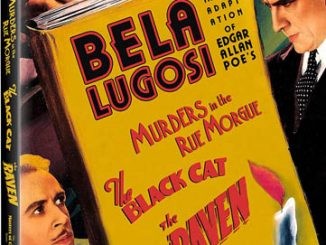

Be the first to comment